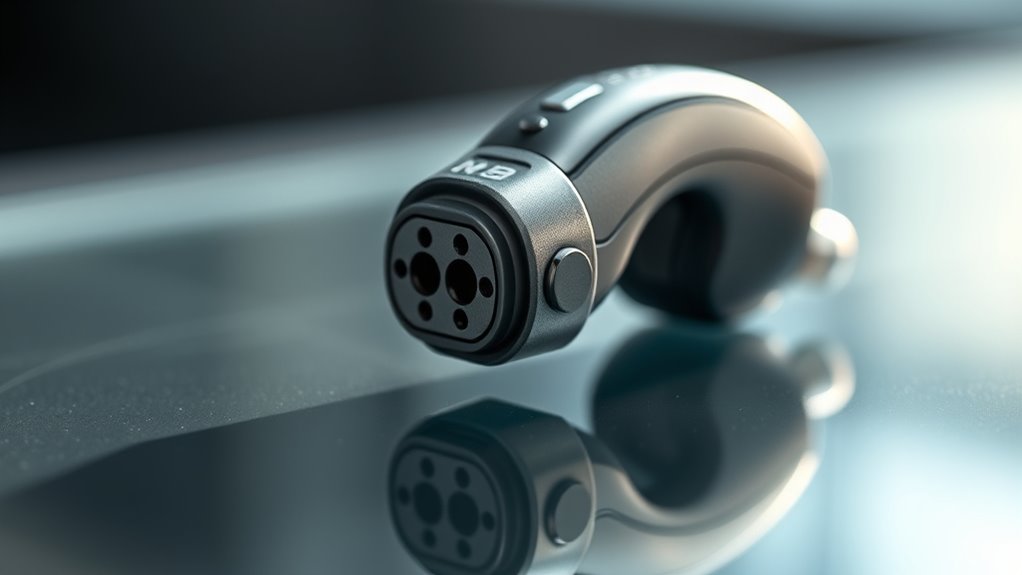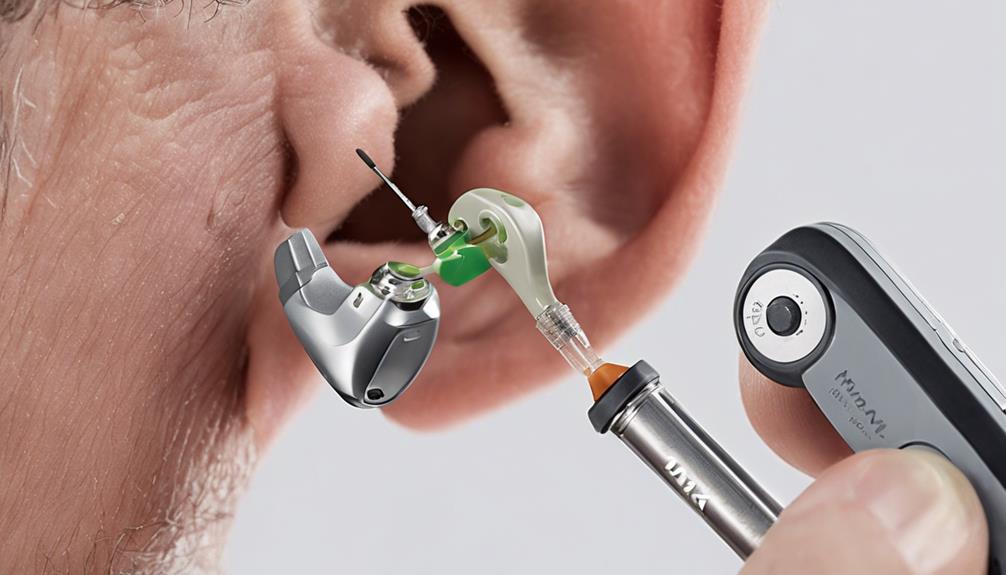Hearing aids use channels and bands to break down sounds into specific frequency ranges, allowing you to customize how your device amplifies different sounds. Channels act as individual pathways for parts of the sound spectrum, making it possible to fine-tune the hearing experience. Bands group broader frequency segments, simplifying adjustments. The combination of channels and bands helps improve speech clarity, reduce background noise, and create a natural listening experience—keep exploring to understand how they work together for your hearing needs.
Key Takeaways
- Channels divide sound into specific frequency ranges for precise sound processing and customization.
- Increasing channels allows more detailed amplification and better separation of speech from background noise.
- Bands group broader frequency segments, simplifying sound adjustments based on individual hearing profiles.
- More channels and bands enhance natural sound quality and improve clarity in diverse listening environments.
- Advanced algorithms optimize amplification across channels and bands for a more comfortable listening experience.

Have you ever wondered how hearing aids customize sound to match your hearing loss? It all comes down to the way they process and deliver audio, which is made possible through the use of channels and bands. These components work together to fine-tune the way sounds are amplified, helping you hear more clearly in various environments. When you put on your hearing aid, it doesn’t just amplify all sounds equally. Instead, it divides incoming audio into multiple frequency ranges, allowing for precise adjustments tailored to your specific hearing needs. This process, known as frequency adjustment, guarantees that you get the most natural and comfortable listening experience possible.
Sound customization is central to how hearing aids operate. By dividing sound into different channels, the device can amplify speech frequencies more prominently while reducing background noise or other unwanted sounds. Think of channels as individual pathways that carry specific portions of the sound spectrum. The more channels your hearing aid has, the more detailed and refined the sound processing can be. For example, if you’re hard of hearing in the high frequencies, the device can increase amplification in that range without affecting the lower frequencies. This selective emphasis makes speech clearer and less fatiguing to listen to over time.
Sound customization via channels enhances speech clarity and reduces background noise for a more natural listening experience.
Bands are similar to channels but tend to refer to broader frequency segments within the overall spectrum. They are used to simplify the sound processing, especially in less advanced hearing aids, but still serve the purpose of sound customization. Modern hearing aids often feature dozens of channels to allow for meticulous adjustments, providing a personalized listening experience. Your audiologist will program these channels and bands based on your hearing profile, guaranteeing that each frequency range is optimized for your hearing loss pattern.
The capability to adjust frequency ranges individually means your hearing aid can better mimic natural hearing, which is inherently tuned to various sound frequencies. This fine-tuning is vital for understanding speech, especially in noisy environments, where separating speech from background sounds becomes more challenging. Additionally, advancements in creative practice have influenced the development of sophisticated sound processing algorithms in hearing aids, leading to even more natural sound quality. The more channels and bands your device has, the better it can adapt to different acoustic situations, delivering clearer sound tailored just for you.
In essence, the combination of multiple channels and bands allows your hearing aid to perform detailed sound customization. It’s a sophisticated process that guarantees you receive the right amplification at the right frequencies, making your listening experience more natural, comfortable, and effective.
Frequently Asked Questions
Can Hearing Aid Channels Be Customized for Individual Hearing Loss?
Yes, hearing aid channels can be customized for your specific hearing loss. During fitting, your audiologist uses fitting strategies to tailor the device, adjusting channels for ideal sound quality. Channel customization allows precise control over different frequencies, helping you hear better in various environments. This personalized approach ensures your hearing aid provides the best possible amplification, improving comfort and clarity based on your unique hearing profile.
How Do Channels Affect Hearing Aid Battery Life?
Ever wondered how your hearing aid’s channels impact battery life? More channels mean increased battery consumption because the device processes more signals and performs complex channel optimization. If you choose fewer channels, it conserves energy, extending your battery life. So, think about your hearing needs: do you want richer sound with shorter battery life or longer-lasting power with simpler settings? Balancing channels helps optimize both sound quality and battery use.
Are More Channels Always Better for Sound Quality?
More channels can improve sound clarity by allowing better customization of different frequencies, but they aren’t always better. You need channel flexibility to balance clarity with simplicity; too many channels can make adjustments complex without substantially enhancing sound quality. Ultimately, the ideal number depends on your hearing needs. Work with your audiologist to find the right balance, ensuring clear, natural sound without unnecessary complexity or battery drain.
Can Users Adjust Channels and Bands Themselves?
You might wonder if you can adjust channels and bands yourself. While some hearing aids offer programming flexibility and user control, not all are designed for DIY adjustments. Many devices require specialized tools and expertise to guarantee the best tuning. If you want to customize your hearing experience, check if your hearing aid provides user-friendly controls or consult your audiologist for professional adjustments, ensuring the best sound quality and comfort.
How Do Channels Influence Background Noise Reduction?
You might think more channels improve noise filtering, but it’s not always true. Channels influence how your hearing aid separates speech from background noise, allowing for better customization. By adjusting channels, you can fine-tune noise reduction, making background sounds less intrusive. Proper channel customization helps your device target specific noises, enhancing clarity. So, your hearing aid’s channels directly impact how effectively it manages background noise, making your listening experience more comfortable.
Conclusion
By understanding hearing aid channels and bands, you’re taking a meaningful step toward clearer conversations and richer sounds. Remember, these tools are like gentle guides, helping you navigate the symphony of life with confidence. With patience and the right settings, you’ll find your hearing experience becomes more natural and fulfilling. Embrace this journey, knowing that each adjustment brings you closer to rediscovering the world’s subtle melodies—your own unique harmony awaits.











